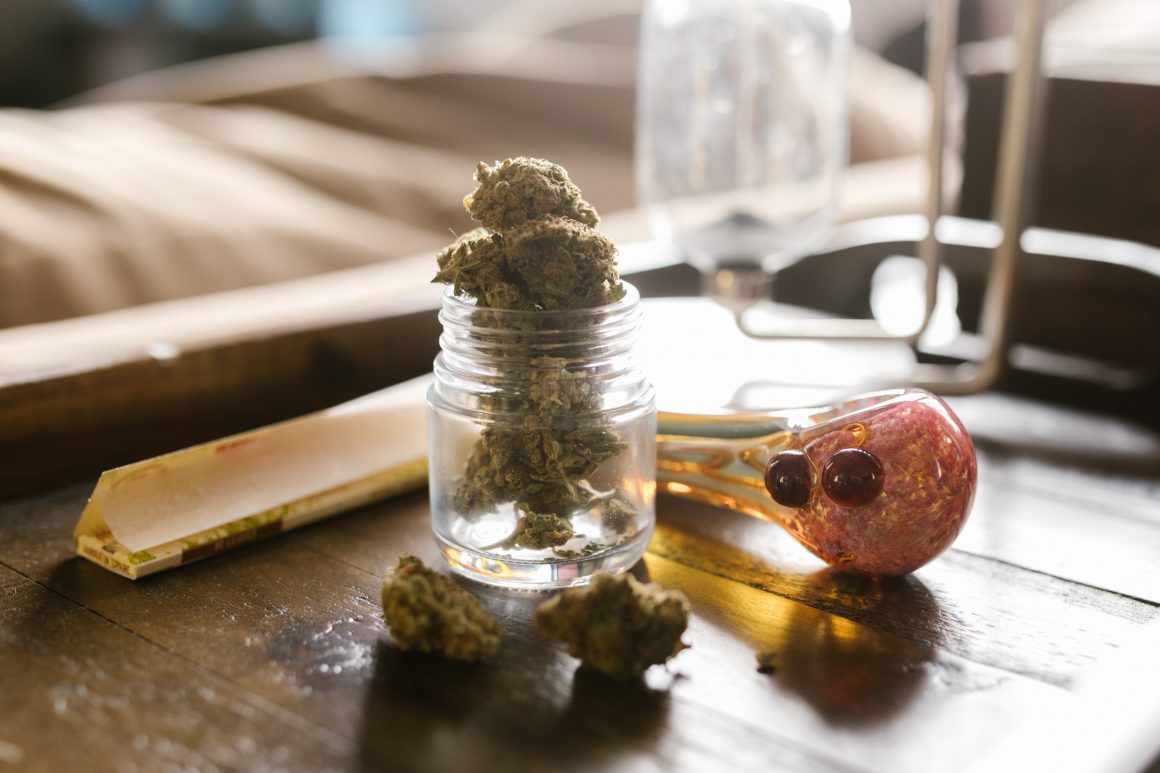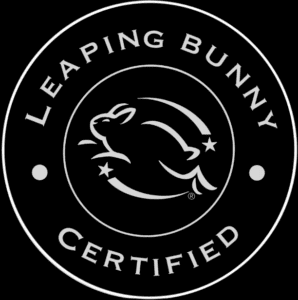4/20: Hitting The High Notes
4/20 (April 20th) is the day when droves of Americans celebrate something that had been prohibited and vilified in our country for decades: cannabis consumption. On 4/20, major rallies occur across the country, particularly in places like Colorado, California, and 16 other states plus Washington DC and Guam, where recreational cannabis consumption has been legalized. In recognition of 4/20 Day, let’s explore the facts and myths behind the name of the day, recount the storied history of the cannabis plant, and highlight the difference between THC and CBD.
How 4/20 Day Got Its Name: Myths and Facts
The myths and stories of how 4/20 Day got its name range from simple rumors to outright puffery. You may have heard about the unofficial holiday when you were a kid from older teens, or you might have Googled 4/20 to learn more. Either way: there’s quite a bit of gray when it comes to the name of the day.
Here are a few of the most common versions of the origins of 4/20 — as well as the actual truth:
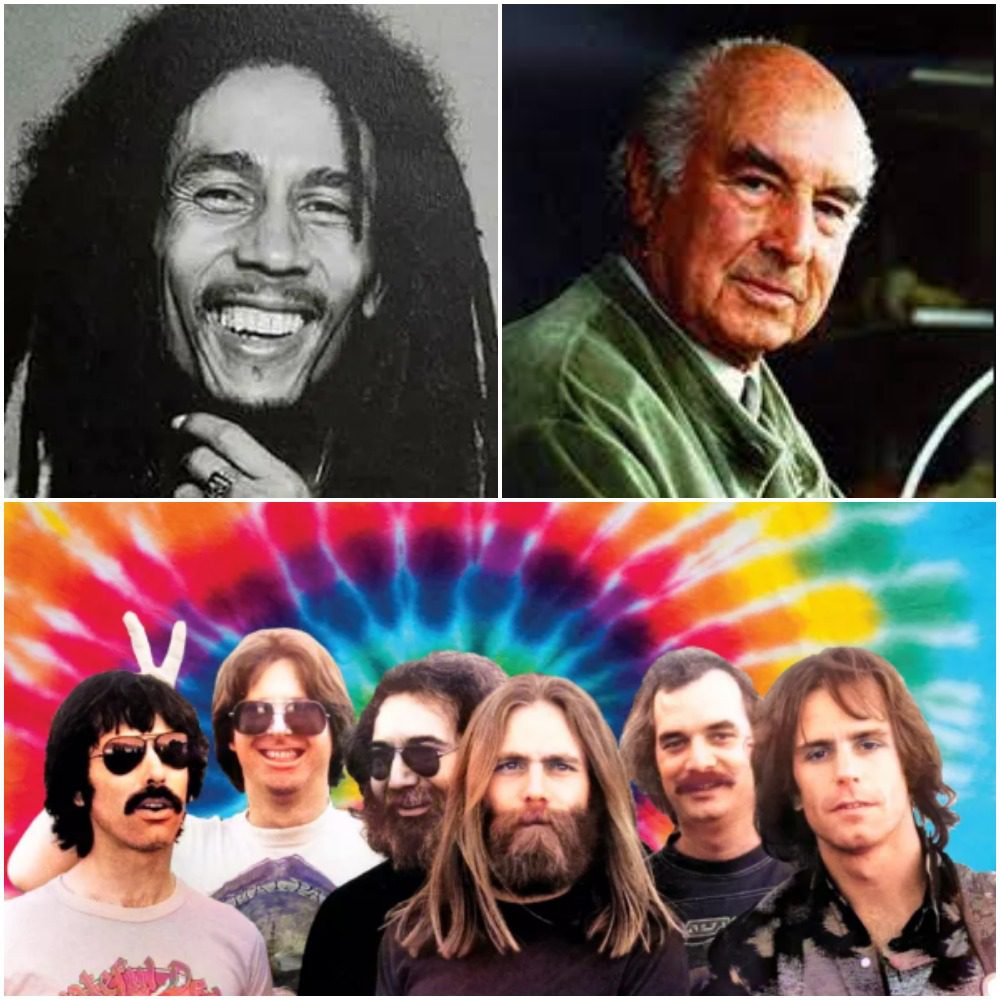
Pictured: Top Left: Bob Marley (Music Universe); Top Right: Albert Hoffman (Pinterest); Bottom: Grateful Dead (Louder Sound)
Myth: Bob Marley
Many people believe 4/20 was inspired by the date of Bob Marley’s death — except he actually died on May 11th, 1981 — or when he was born, though his birthday is actually February 6th, 1945. This 4/20 creation myth is often repeated for Jimi Hendrix, Janis Joplin, Jim Morrison, or anyone else associated with the “27 Club.”
Myth: 420 Radio Code
Rumor has it that 420 is the police code for “cannabis smoking in progress” or for “possession” or the penal code for cannabis use — none of which are factual. 420 is actually the radio code for homicide.
Myth: Chemistry
Many people believe that there are 420 chemical compounds in the cannabis flower, but in actuality, there are only 315 chemicals in cannabis, and that’s without getting technical.1
Myth: Albert Hoffman
As evidenced by his lab notes, it’s true that Albert Hoffman, the Swiss chemist who discovered LSD, took his first deliberate LSD trip on April 20th, 1943, but most argue that this wasn’t the source of 4/20; instead being a crazy coincidence.2
Myth: Grateful Dead
This rumor has apparently been denied by a Grateful Dead Productions spokesman, but there does remain a connection with 4/20 and the Grateful Dead.3 The band’s fans can be credited with spreading the “wake-and-bake” message of 4/20 across the country, and the true origin is said to hail from the same Northern California county as the The Grateful Dead.
Truth: 4/20 Was Created by Friends
Various sources, including Wikipedia, Snopes, and even the BBC, agree that 4/20 was first coined by a group of students at San Rafael High School in the early 1970s. The group called themselves “The Waldos” because they liked to socialize in front of a particular wall outside their school. They set a plan to find an abandoned cannabis crop and designated 4:20 pm as their meeting time to start their treasure hunt. They never found the crop, but started using the codeword “420” to communicate with each other about getting high.
According to a Waldo quoted in the San Francisco Chronicle in 2000, the simple codeword soon came to stand in for anything cannabis-related, with hallway whispers of 420 standing in for questions like, “Do I look stoned?” or “Do you have any?”4 By the end of the 1970s, the term had been picked up by the Grateful Dead and their fans, before spreading across the country and eventually around the world.
While the Waldos initially tried to keep their identities under wraps, with time they came out to the media, bringing evidence to support their claims with letters dated and postmarked in the 1970s mentioning the all-mysterious “420.” Today, many who partake in cannabis more frequently will enjoy doing so at 4:20 pm as an ode to the code.

Pictured: The Waldos Source: Green Screens
Ancient Roots of Cannabis Use
The medicinal properties of the cannabis plant have been known for millennia; dating as far back as 2800 BC, when cannabis was used to treat a vast array of health problems and was listed in Emperor Shen Nung’s (regarded as the father of Chinese medicine) pharmacopoeia.5
Therapeutic indications of cannabis are mentioned in the texts of the Indian Hindus, Assyrians, Greeks, and Romans. These texts reported that cannabis treats a vast array of different health problems, including arthritis, depression, amenorrhea, inflammation, pain, lack of appetite, and asthma.6
Hindu legend holds that Shiva was given the title “The Lord of Bhang,” because the cannabis plant was his favorite food. The ancient Hindus thought the medicinal benefits of cannabis were explained by pleasing the gods.7
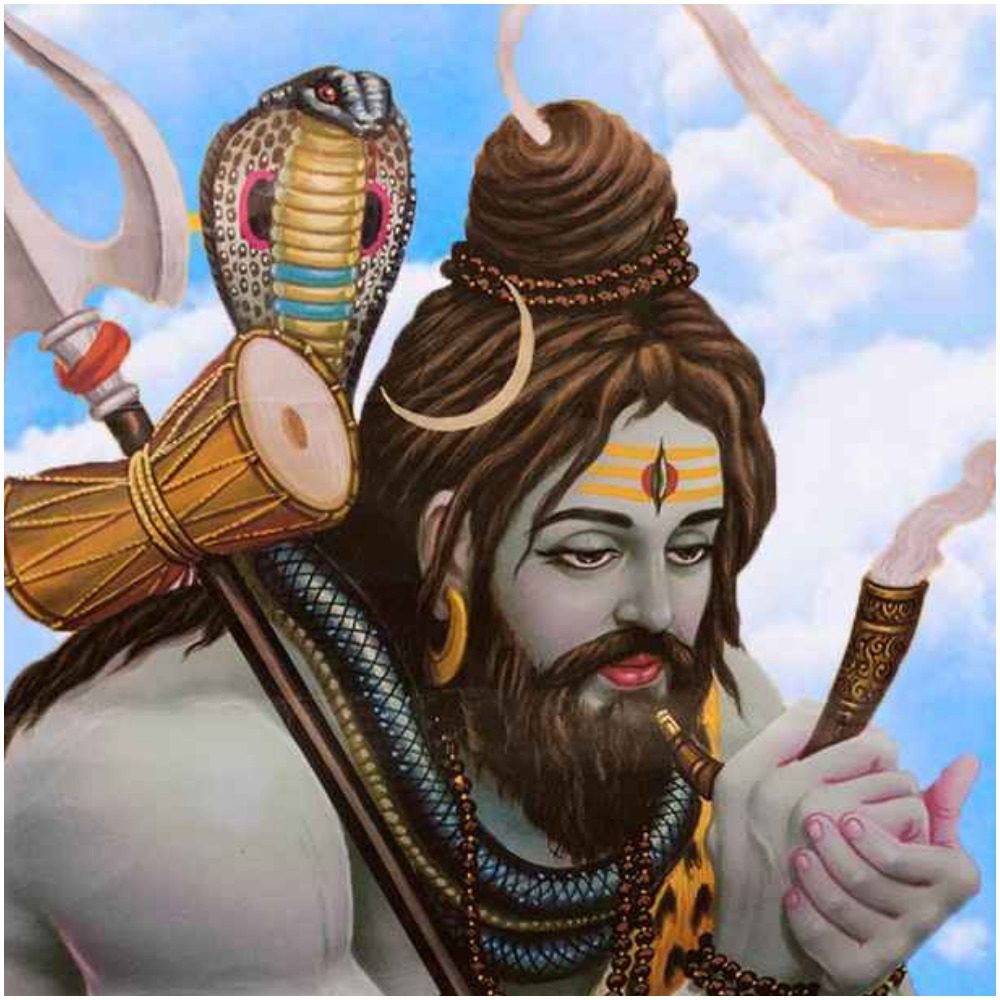
Pictured: Shiva with a cannabis pipe Source: Binge Daily
Ancient Hindu texts attribute the onset of fever to the “hot breath of the gods” who were angered by the afflicted person’s behavior. Using cannabis in religious rites appeased the gods and hence reduced the fever.8
These early cannabis plants had very low levels of tetrahydrocannabinol (THC), the chemical responsible for its mind-altering effects. However, there’s some evidence that ancient cultures knew about the psychoactive properties of the cannabis plant, so they may have cultivated varieties to produce higher levels of THC to use in religious ceremonies or healing practices.9
Cannabis Cultivation in Early America
The history of cannabis cultivation in America dates back to the early colonists who grew hemp for textiles and rope.9 The hemp plant originally evolved in Central Asia before people introduced the plant into Africa, Europe, and eventually the Americas.10
Because cannabis is a fast-growing plant that’s easy to cultivate and has many uses, it was widely grown throughout colonial America and at Spanish missions in the Southwest. In the early 1600s, the Virginia, Massachusetts, and Connecticut colonies even required farmers to grow the plant.
As new products were imported or developed to replace hemp — such as cotton — the plant fell out of popularity. By the end of the Civil War, the United States’ hemp production had passed its peak, but the plant was soon to see another rise in popularity.12
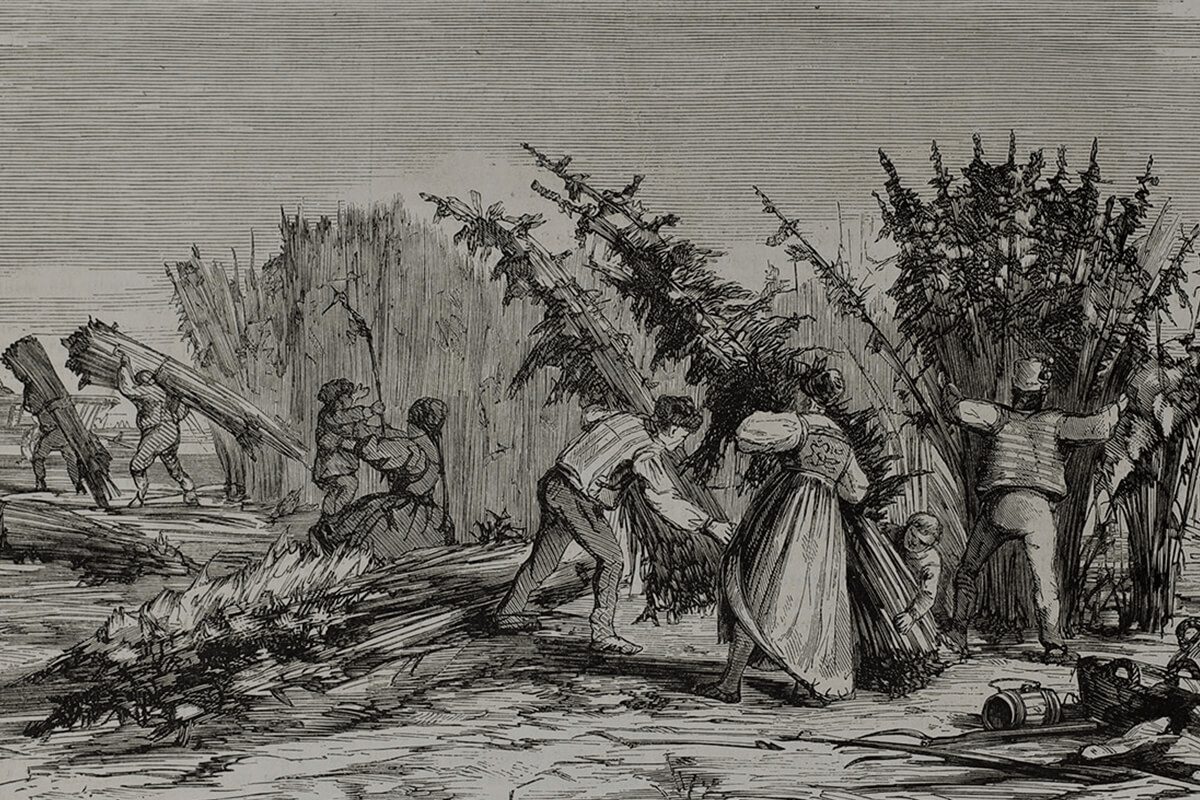
Pictured: Early cannabis/hemp farming Source: Fortuna Hemp
The Vilification of Cannabis
To put it bluntly, cannabis criminalization in the US stems from roots of white supremacy, power, and control. In the 1930s, xenophobic government bureaucrats, seeking to maintain ‘decorum,’ initiated a prohibition on cannabis, which, at the time, was mostly being used in the Hispanic and African American communities. They painted cannabis — and the communities using it — as a threat to the already crippled country and began the process of banning it.15 Twenty-nine states had outlawed cannabis by 1931, and in 1937, the Marijuana Tax Act was passed, essentially making the plant illegal in the United States.
The Beat Generation emerged early in the 1950s when a group of young people began to unite in their rejection of conventional society in favor of artistic and bohemian ideals. The Beatniks also enjoyed experimenting with drugs, particularly cannabis.13,14
Richard Nixon’s administration further propagandized cannabis use with its highly publicized ‘War On Drugs,’ which was actually a sham created to sanction law enforcement to raid, search, arrest, and lock up anti-war hippies and black community members that challenged their leadership.
The Cannabis Renaissance
With unsustainable non-violent incarcerations, broader awareness for the racially motivated criminalization, and mounting scientific evidence as to its wellness benefits, lawmakers have begun relaxing cannabis restrictions. However, federal laws differ from state laws, and state laws vary significantly, making the legalities of selling and consuming cannabis quite hazy.
The first major move was when the US federal government legalized the sale of hemp in the 2018 Farm Bill. Hemp is defined by the government as Cannabis sativa that is bred for industrial applications and low concentration of psychoactive THC (Tetrahydrocannabinol). In the U.S. hemp is defined as a Cannabis sativa plant not containing more than 0.3% THC. For that reason, hemp is considered to be the ‘non-intoxicating’ form of cannabis though it is not entirely free of intoxicating compounds.
Regarding state law, at the time of this writing, all 50 states have decriminalized industrial hemp commerce, including CBD (Cannabidiol), a therapeutic active compound derived from industrial hemp plants. Thirty seven states plus DC have legalized cannabis for medical use only. Eighteen states plus Washington DC have legalized cannabis for both recreational and medical cannabis use.
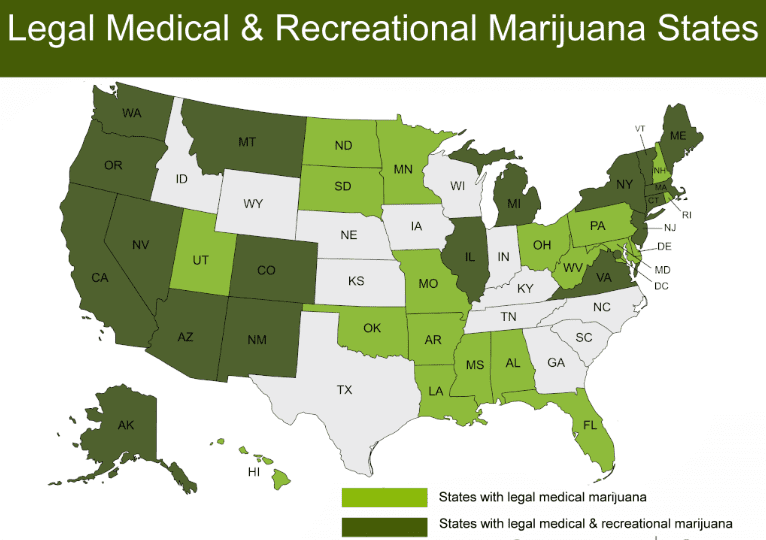
Pictured: Legal medical and recreational marijuana states Source: Britannica Pro Con
CBD vs. THC: The Basics
The cannabis plant is unique considering it produces a family of chemicals called cannabinoids. These chemicals all have a similar three-dimensional shape. However, subtle differences in the shape of these chemicals can have a big impact on how they make us feel.
The two most common cannabinoids are tetrahydrocannabinol (THC) and cannabidiol (CBD). Cannabis plants that produce mind-altering effects are typically high in THC, and cannabis plants with high CBD and little or no THC are legally defined as hemp.
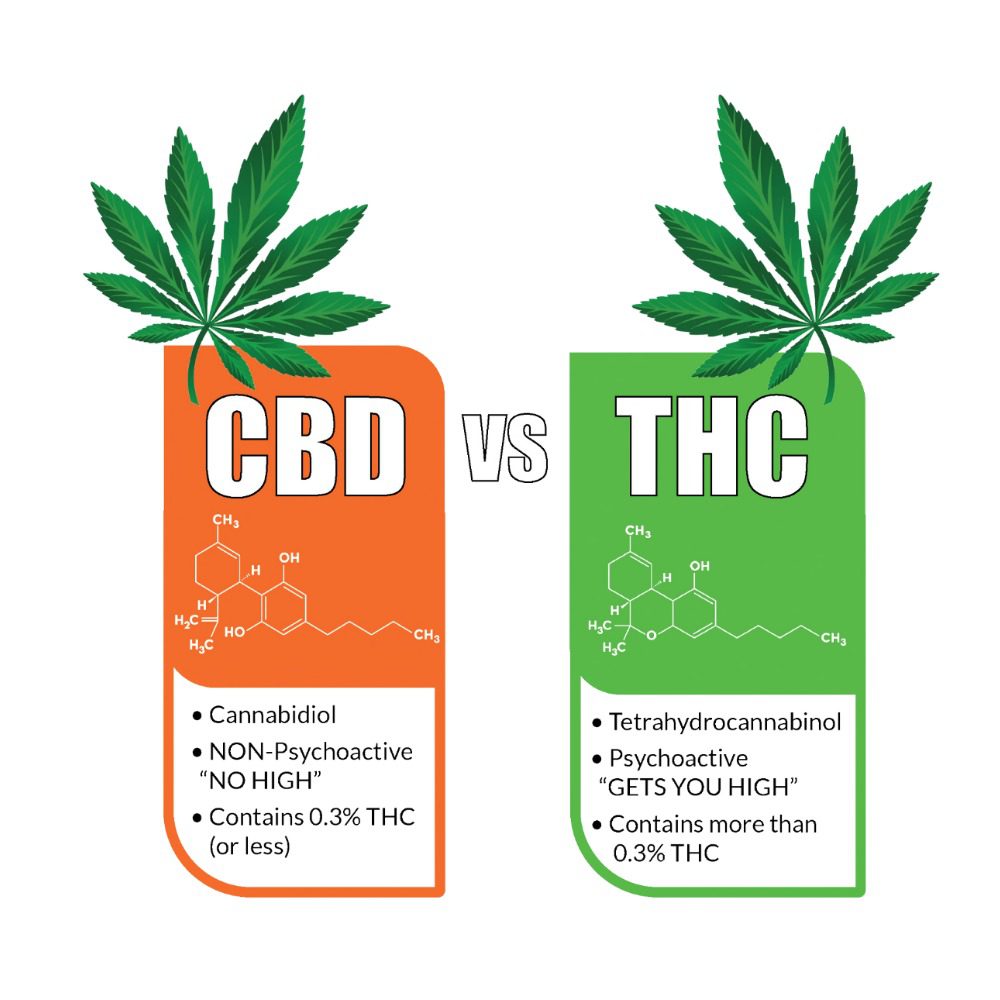
Pictured: CBD vs. THC Source: CBD Lion
CBD is often used to alleviate symptoms associated with:
- Anxiety
- Depression
- Inflammation
- Migraines
- Post-Traumatic Stress Disorder (PTSD)
- Seizures
THC, which may be administered as medical cannabis, may be used to alleviate symptoms of a number of conditions, such as:
- Glaucoma
- Insomnia
- Nausea; may be helpful for alleviating nausea caused by cancer treatment
- Pain associated with conditions such as arthritis, fibromyalgia, and migraine headaches
- Poor Appetite; including appetite problems caused by cancer treatment
- Tremors
The Benefits of Cannabis Usage
Cannabis legalization has resulted in a large increase in use for personal and health reasons. In fact, more than two out of three Americans have legal access to medical cannabis, and more than a quarter can use it recreationally.16
In 2020, researchers examined the impact of federal legalization in Canada and found that 56% of people said that cannabis is beneficial for their quality of life, while 46% of people reported that cannabis is beneficial for their mental health.17
Human research on cannabis’ effectiveness for many diseases is still ongoing. However, the most well-studied benefits of cannabis are:
For Neurological Conditions and Multiple Sclerosis
There are several FDA-approved cannabis-like medications. That is, these medicines are cannabinoids or cousins of the unique chemicals produced by the cannabis plant. Cannabidiol, for example, (Epidiolex) — prescription-level CBD that is used to treat a rare form of epilepsy in children — is made directly from the plant.
Cannabis is also used for diseases like multiple sclerosis (MS). Research is ongoing, but some studies suggest that cannabis may also help neurodegenerative diseases like Parkinson’s and Alzheimer’s.18
For Nausea, Vomiting, and Low Appetite
Cannabis has been used to treat nausea for millennia. Although its effectiveness for treating chemotherapy-induced nausea is widely recognized even in modern times, the use of cannabis for nausea remains under-researched in the general population.
However, in a recent study, titled “The Effectiveness of Common Cannabis Products for Treatment of Nausea” published in the Journal of Clinical Gastroenterology, researchers showed that the vast majority of patients using cannabis to treat nausea experienced relief within one hour.19
For Pain
One of the most common reasons people use cannabis is to manage pain. According to the University of Colorado Boulder, more than 87% of medical cannabis users report smoking or ingesting it for pain-related conditions.
Recent research suggests that cannabis may be a safer choice compared to other pain-relieving drugs such as opioids and benzodiazepines, considering that cannabis’ side effects are not life-threatening. Opioids and benzodiazepines, on the other hand, cause thousands of accidental drug overdoses every year.20
For Sleep
Both individuals with and without chronic diseases report that cannabis improves their sleep. Some studies show that cannabis can help people fall asleep faster, but it may not prevent waking up in the middle of the night.21
Although research is still ongoing, cannabis may also be helpful for those with sleep disorders, such as restless leg syndrome.22
For Mental Health Conditions
Many individuals use cannabis for anxiety, depression, and post-traumatic stress disorder (PTSD). A recent study of people with clinical depression found that those using medical cannabis had lower depression scores than those who were not. It was also determined that study participants who began using medicinal cannabis in a follow-up period saw a reduction in symptoms.23
Humanist Beauty Skincare Products Contain CBD
The Humanist Beauty Herban Wisdom® Facial Oil and Eye Cream both contain cannabinoids sourced from hemp that’s grown with care on US farms using organic practices and that are registered with respective State Departments of Agriculture and operate in strict compliance with state and federal law.
The organic CBD in all Humanist Beauty facial skincare products comes from a blend of full-spectrum whole hemp extract and pure organic CBD isolate. All finished formulas contain less than 0.3% THC.
We chose to include a full-spectrum cannabinoid profile in appreciation for the topical ‘entourage effect’ – synergistic activity where the sum of natural benefits is greater than its parts. CBD is reported to calm sensitivity and provide antioxidant effects, while also visibly soothing skin.
Our formulas are non-intoxicating and applying them topically cannot get you “high.”
You can learn more about our CBD and how we triple-test our products for cannabinoid quality here.
The Humanist Beauty Herban Wisdom® Facial Oil
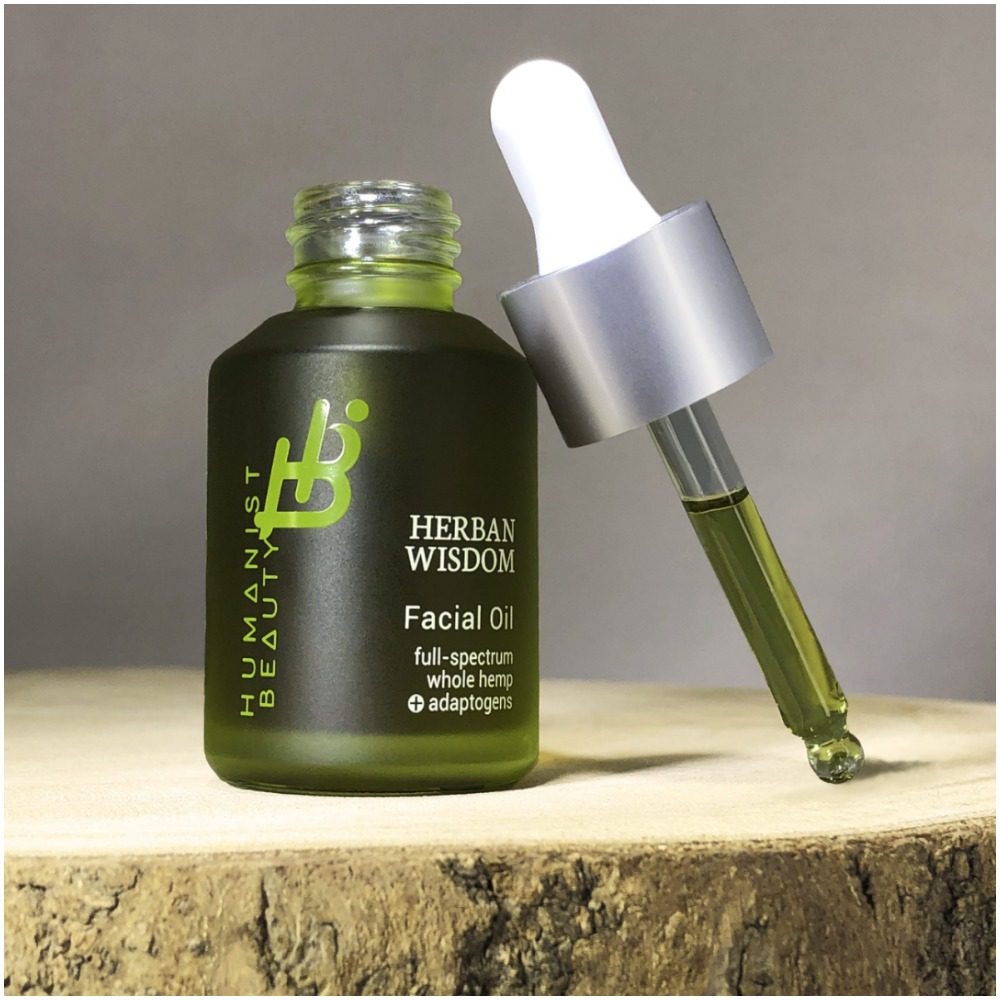
There’s a reason why Herban Wisdom® Facial Oil is heralded as “liquid gold.” The exceptional formula, which harnesses the full power of CBD, is a powerful skin treatment fusing clean plant nutrients rich in antioxidant, adaptogenic, anti-aging, and moisturizing properties.
The Herban Wisdom® Facial Oil oil can be applied to help visibly repair, deeply nourish, and diminish signs of stress on your skin twice daily. As part of your holistic wellness regimen, it can also be used on pulse points and other skin externalities to help aromatically calm and soothe your mind, body and soul.
You can shop the Herban Wisdom® Facial Oil here.
The Humanist Beauty Herban Wisdom® Eye Cream
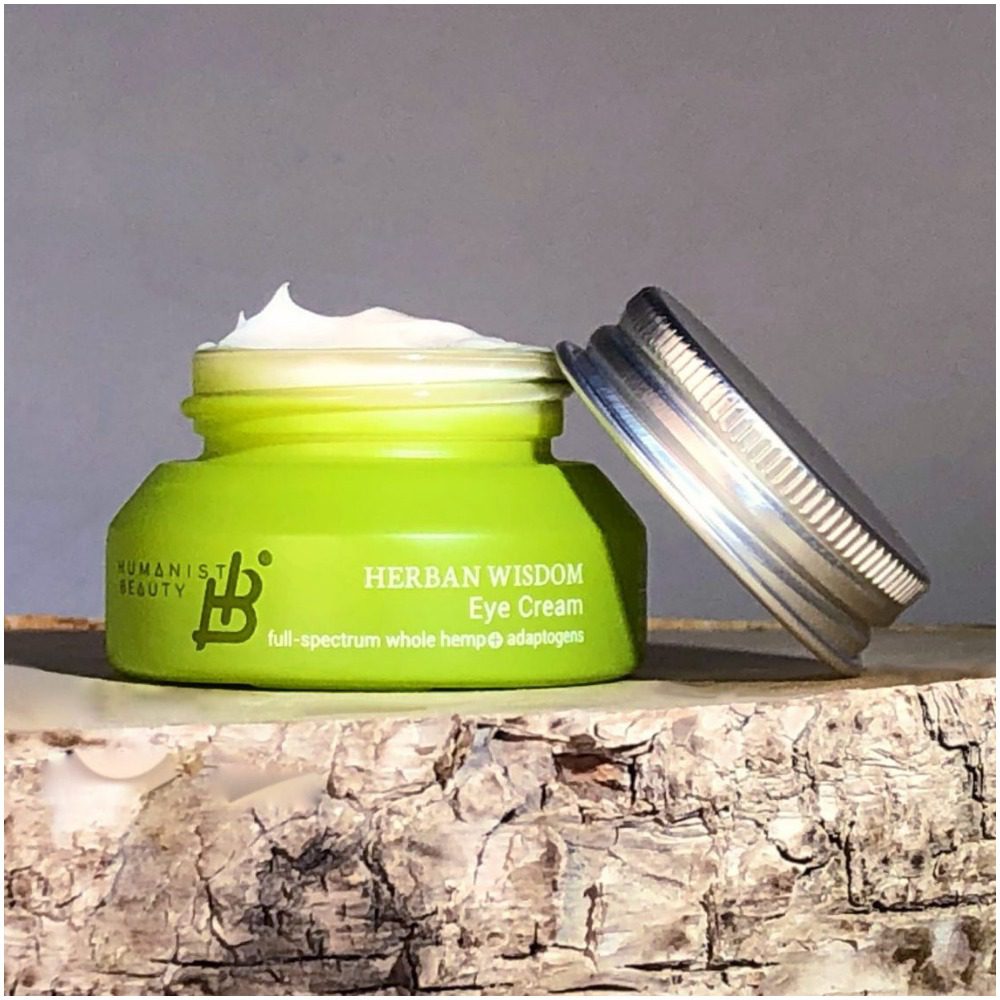
The Humanist Beauty Herban Wisdom® Eye Cream is packed with skin-rejuvenating plant-based nutrients, full-spectrum CBD, adaptogens, and antioxidants. This eye cream helps to balance the skin’s stress response and defend against premature fine lines, wrinkles, laxity, and collagen-loss, while revitalizing the skin to increase luminosity and diminish noticeable eye bags, puffiness, and signs of fatigue.
This intuitive eye cream immediately goes to work upon application, renewing the delicate skin around your entire eye area. The concentrated formula has a dense consistency that sinks in and stays put; it won’t run into your eyes or sting, and can be used alone or under makeup both day and night.
You can shop the Humanist Beauty Herban Wisdom® Eye Cream here.
Products Containing CBD to Take Note Of
In 2021, BDSA’s trend report forecasted the CBD beauty segment of the market to reach $720 million — a 60% increase over 2020 and representing just 10% of the total CBD market. By 2024, the CBD beauty market is projected to reach $959 million.24
With that being said, the number of new brands and product launches that contain CBD to consider buying is overwhelming. Here are four esteemed CBD products to take note of:
Happy Dance Look Alive Face Moisturizer
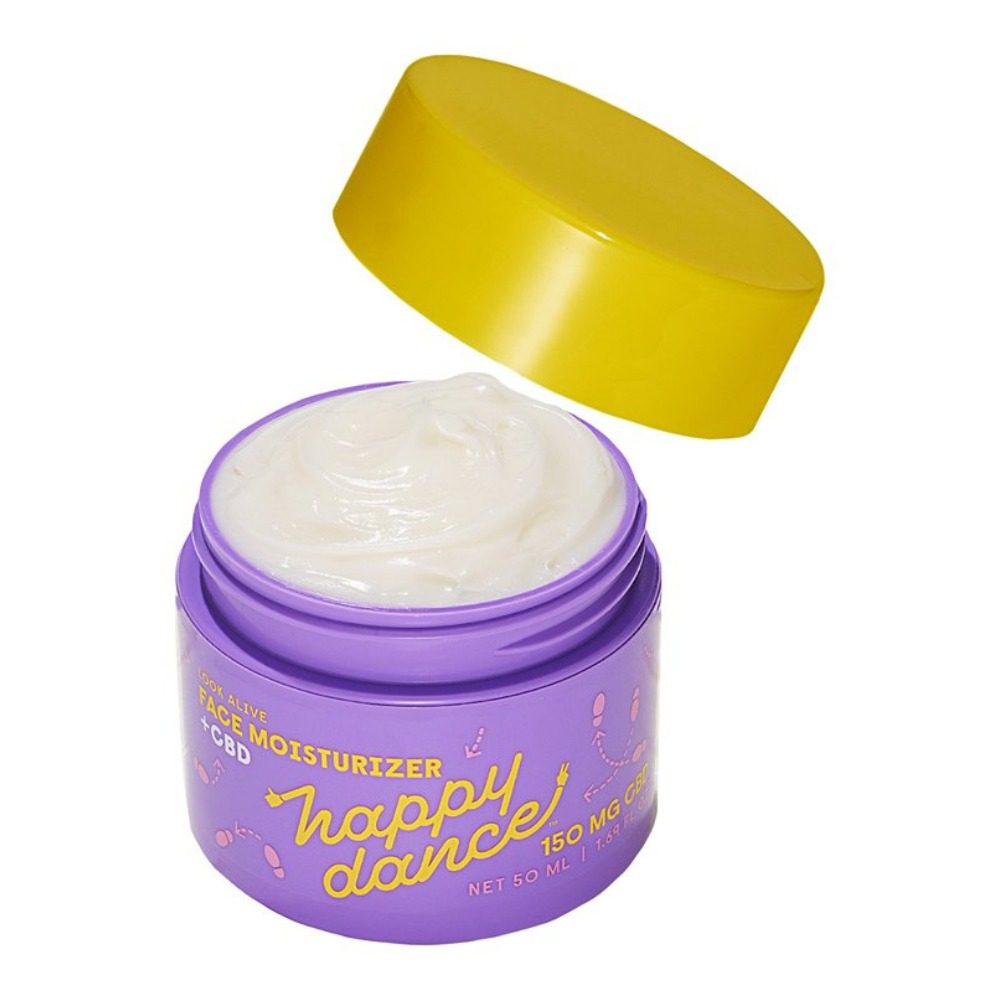
For celebrity co-founder Kristen Bell, the havoc wreaked on her skin from the normal stresses of the day was the inspiration for creating Happy Dance’s debut face moisturizer. Formulated as a “first line of defense,” this whipped, hydrating cream is light on the skin, but heavy on hydration. It’s infused with 150 milligrams of CBD extract, along with being powered by avocado oil, bisabolol with a ginger blend, and four types of hyaluronic acid.
You can shop the Happy Dance Look Alive Face Moisturizer here.
Khus + Khus Bleu Body Wax
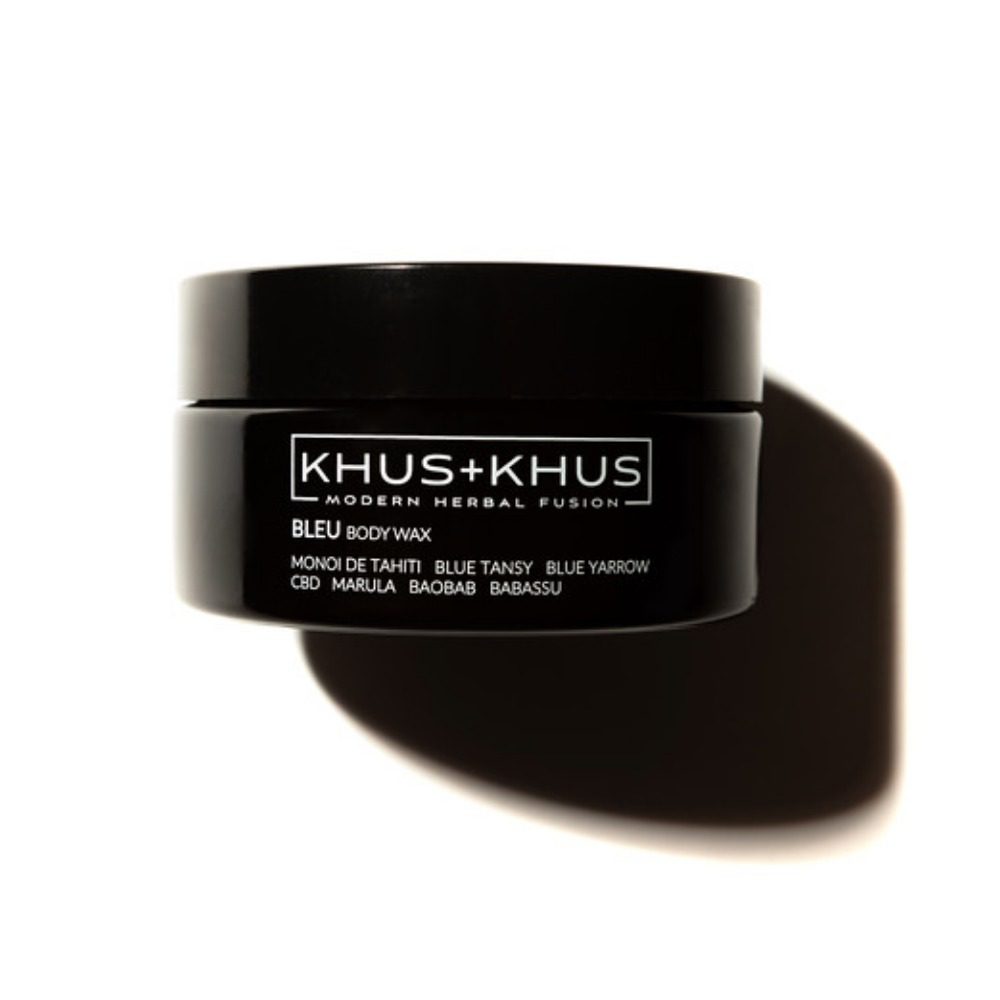
Khus + Khus founder Kristi Blustein is an Ayurvedic specialist, aromatherapist, and herbalist, which takes the brand and its products to the next level. The Bleu Body Wax, for example, is a concentrated pomade that’s solid at room temperature and when warmed up in your hands, liquifies for smooth application. Each jar is packed with 225 milligrams of CBD that’s complemented by coconut, baobab seed, and beeswax with essential oils.
You can shop the Khus + Khus Bleu Body Wax here.
Prima Beyond Body Oil
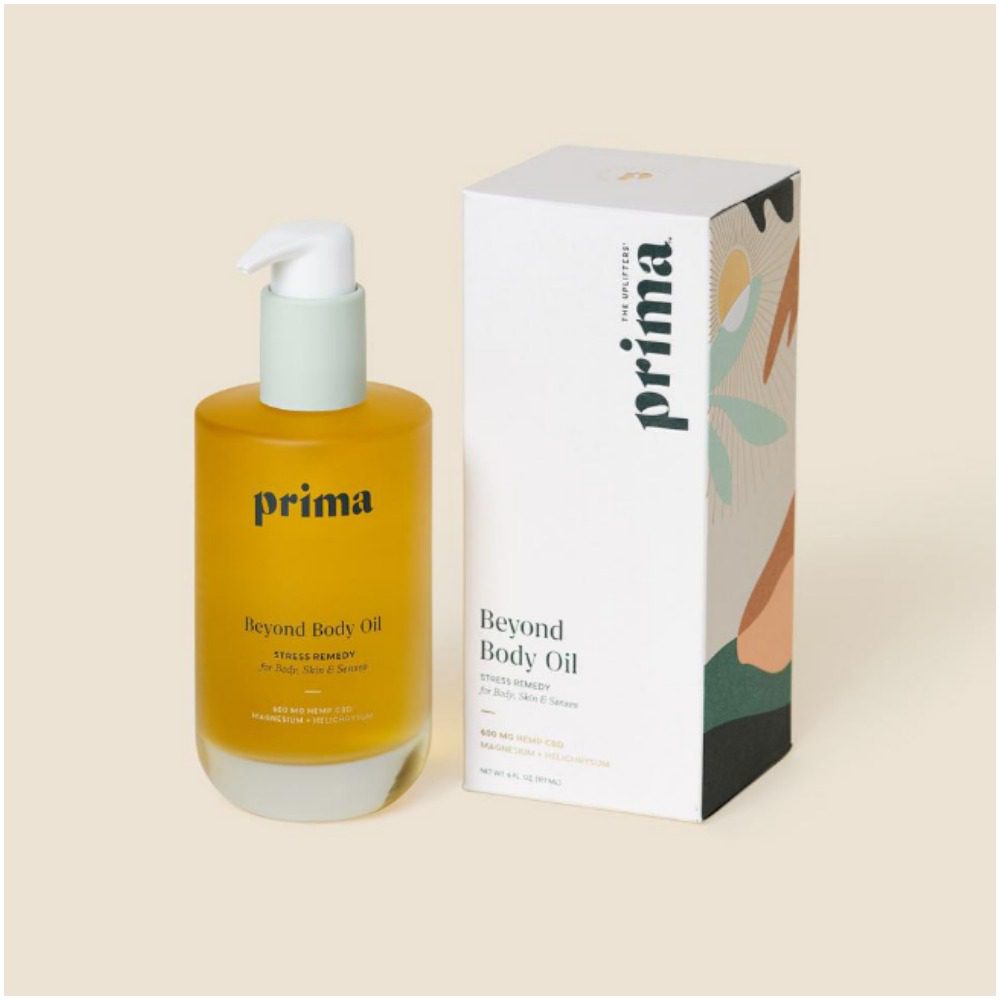
Supercharged with 600 milligrams of CBD oil per bottle, Prima’s Beyond Body Oil goes beyond your average body oil. Plant actives including omegas, phenols, antioxidants, and fatty acids are combined with magnesium and helichrysum in this soothing, therapeutic formula, which repairs and restores the skin while also improving tone and texture.
You can shop the Prima Hemp Beyond Body Oil here.
Undefined Beauty Glow Drops
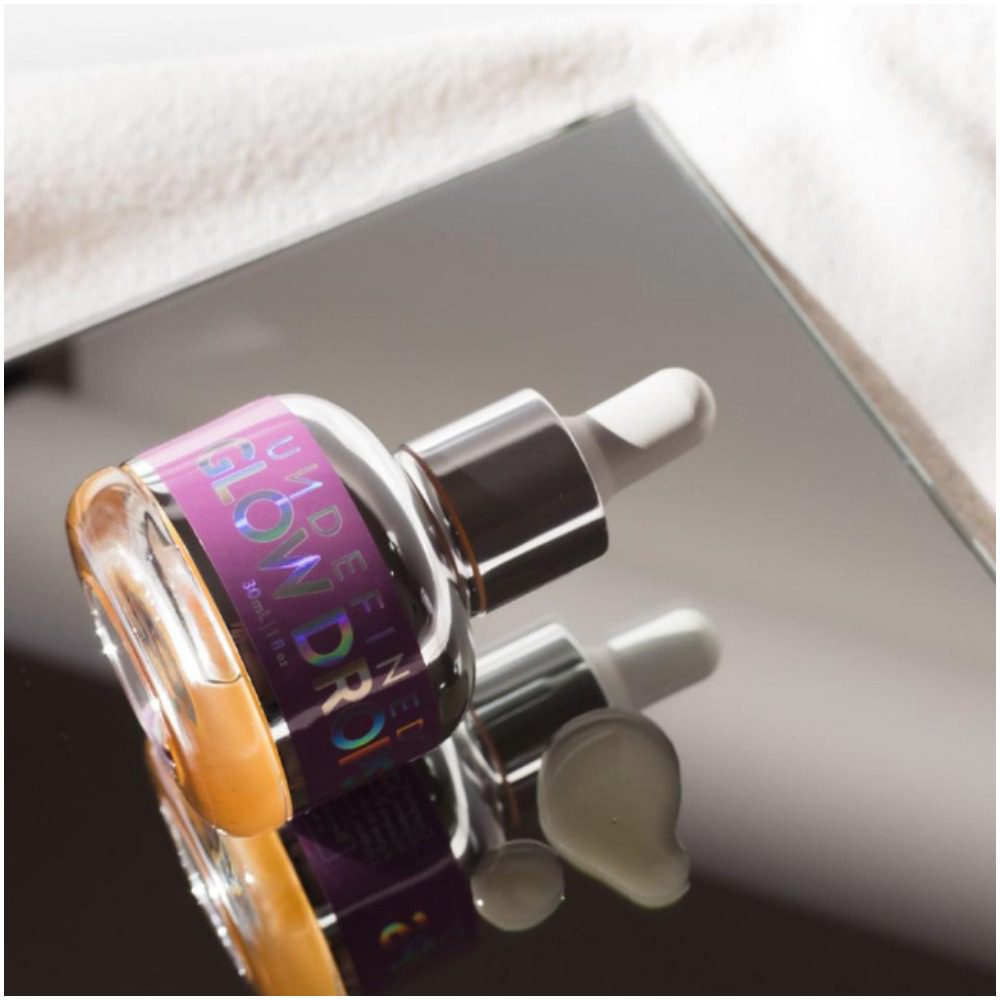
Undefined Beauty’s Glow Drops are not your standard tincture. The Glow Drops combine antioxidant-rich adaptogens, superfoods, and potent 600 mg full-spectrum CBD to boost your mood, support gut health, promote beauty from the inside out, and protect against UV light, smog, and stress for glowing skin. You can add a few drops under your tongue or into your favorite beverage.
You can shop Undefined Beauty’s Glow Drops here.
Do you have any products containing CBD that you love? Do you celebrate 4/20, and if so, how? Let us know in the comments!
–
References:
https://hightimes.com/read/world-goes-smoke-each-april-20 [1]
https://www.scientificamerican.com/article/inventor-of-lsd-embarks-on-final-trip/ [2]
https://hightimes.com/read/world-goes-smoke-each-april-20 [3]
https://www.sfgate.com/bayarea/article/Stoner-Chic-Traces-Origin-To-San-Rafael-2763464.php [4]
https://sanctuarywellnessinstitute.com/cannabis/medical-marijuana-history.php [5]
https://www.ncbi.nlm.nih.gov/pmc/articles/PMC5312634/ [6]
https://www.elixinolwellness.com/site/blog/hemp–cannabis-and-religion [7] [8]
https://www.science.org/doi/10.1126/sciadv.aaw1391 [9] [12]
https://www.thestreet.com/markets/history-of-marijuana-14718715 [10]
https://ministryofhemp.com/hemp/history/ [11]
https://www.britannica.com/art/Beat-movement [13]
https://www.pbs.org/wgbh/pages/frontline/shows/drugs/buyers/socialhistory.html [14]
https://www.pbs.org/wgbh/pages/frontline/shows/dope/etc/cron.html [15]
https://www.ncbi.nlm.nih.gov/books/NBK425767/ [18]
https://nida.nih.gov/drug-topics/trends-statistics/overdose-death-rates [20]
https://pubmed.ncbi.nlm.nih.gov/31954953/ [21]
https://pubmed.ncbi.nlm.nih.gov/33537945/ [22]
https://bdsa.com/ [24]

